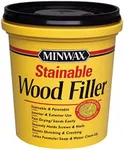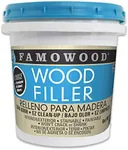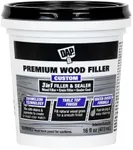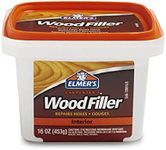Buying Guide for the Best Outdoor Wood Fillers
Choosing the right outdoor wood filler is important for repairing and maintaining wood surfaces exposed to the elements, such as decks, fences, or outdoor furniture. The best wood filler for you will depend on the type of repair, the size of the area, and the conditions the wood will face. Understanding the key specifications will help you select a product that lasts, blends well, and is easy to work with.Durability and Weather ResistanceDurability and weather resistance refer to how well the wood filler stands up to outdoor conditions like rain, sun, and temperature changes. This is important because outdoor wood is constantly exposed to the elements, and a filler that isn't weather-resistant can crack, shrink, or wash away. Some fillers are designed for light, sheltered use, while others are made for heavy-duty, exposed areas. If your repair is in a spot that gets a lot of sun or rain, look for fillers labeled as 'exterior' or 'weatherproof.' For covered or less exposed areas, a standard outdoor filler may be enough.
Sandability and PaintabilitySandability and paintability describe how easily the filler can be smoothed and finished after it dries. This matters because you often want the repair to blend in with the surrounding wood. Some fillers can be sanded to a very smooth finish and accept paint or stain well, while others may remain rough or resist coloring. If you plan to paint or stain the repaired area, choose a filler that specifically says it can be sanded and painted or stained. For hidden or less visible repairs, this may be less important.
Drying TimeDrying time is how long the filler takes to harden enough for sanding, painting, or use. This is important if you need to finish your project quickly or if the area is exposed to weather soon after repair. Fillers can range from quick-drying (ready in 15-30 minutes) to slow-drying (several hours or overnight). If you need a fast turnaround, look for a quick-drying formula. For larger or deeper repairs, a slower-drying filler may be better, as it can cure more thoroughly.
Application MethodApplication method refers to how the filler is applied—some come in tubs for spreading with a putty knife, others in tubes for squeezing into cracks, and some are two-part mixtures that need to be combined before use. This matters because the size and shape of your repair will determine which is easiest to use. For small cracks or nail holes, a tube or squeeze bottle is convenient. For larger gaps or rebuilding corners, a spreadable or moldable filler is better. If you have a big or complex repair, a two-part filler can offer extra strength.
Shrinkage and CrackingShrinkage and cracking refer to whether the filler reduces in size or develops cracks as it dries. This is important because shrinkage can leave gaps, and cracks can let in moisture, leading to further damage. Some fillers are formulated to minimize shrinkage and stay stable over time. If you are filling deep or wide gaps, look for a low-shrinkage product. For shallow or cosmetic repairs, this may be less of a concern.
















